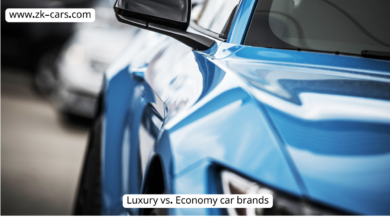
In today’s competitive marketplace, brand positioning is vital in defining how consumers perceive a company and its products. There are two primary forms of brand positioning: luxury and economy. Each approach has distinct strategies and target markets. These strategies have implications for long-term success. Luxury brands evoke images of exclusivity, prestige, and high quality. In contrast, economy brands appeal to practicality, affordability, and accessibility. In this article, we will explore the differences between luxury and economy brand positioning, the strategies behind each, and how they shape consumer perceptions.
1. Understanding Brand Positioning
Brand positioning refers to how a company places its product in the minds of consumers compared to competitors. It involves creating a unique identity, message, and value proposition that resonates with the target audience. Companies use brand positioning to differentiate themselves from competitors. This helps establish an emotional connection with customers and influences purchasing decisions.
What is Luxury Brand Positioning?
Luxury brand positioning aims to create a sense of exclusivity, quality, and prestige. Luxury brands target affluent individuals or aspirational consumers willing to pay a premium for experiences, craftsmanship, and status. Examples of luxury brands include Louis Vuitton, Rolex, Chanel, and Rolls-Royce.
Luxury brands often emphasize:
- Premium Pricing: High price tags reflect exclusivity and quality.
- Exceptional Quality: These brands use the finest materials and craftsmanship.
- Brand Heritage and Tradition: A rich history adds to prestige.
- Exclusivity and Scarcity: Limited production runs drive demand.
What is Economy Brand Positioning?
Economy brand positioning targets a broader audience by focusing on affordability, functionality, and value for money. Economy brands appeal to cost-conscious consumers who seek practical solutions without paying a premium. Well-known economy brands include Walmart, IKEA, Target, and Kia.
Key characteristics of economy brand positioning include:
- Affordability: Lower prices than premium counterparts.
- Value for Money: Highlights the practical benefits and functionality.
- Mass Market Appeal: Products are accessible to many consumers.
- Efficiency and Convenience: Emphasizes reliability and ease of use.
2. The Core Differences Between Luxury and Economy Brand Positioning
A. Price and Perceived Value
A noticeable difference between luxury and economy brand positioning is price. Luxury brands maintain high price points to signal exclusivity, quality, and status. For consumers, owning a luxury product often goes beyond functionality. It’s about the prestige and social standing it conveys.
In contrast, economy brands aim to offer the best possible value for money. Their products fulfill specific needs or functions at competitive prices. While economy brands may not evoke the same emotional response as luxury brands, they attract customers seeking affordable, practical solutions.
B. Target Audience
Luxury and economy brands serve very different target markets. Luxury brands typically target a niche, affluent customer base. These consumers value high-end materials, craftsmanship, and the prestige of luxury ownership. On the other hand, economy brands cater to the mass market, focusing on middle-income consumers who prioritize cost-effectiveness and functionality.
- Luxury Target Market: Affluent individuals, aspirational buyers, professionals.
- Economy Target Market: Price-conscious individuals, families, budget shoppers.
C. Emotional vs. Practical Appeal
Luxury brands often evoke strong emotional connections. Owning a luxury product is not just about fulfilling a need. It’s about the experience, status, and pride associated with it. Consumers often feel a personal attachment to the brand, viewing it as part of their identity.
Conversely, economy brands focus on practicality. Their messaging centers around the product’s utility and reliability. The emotional connection with economy brands is often functional, focusing on how well the product meets daily needs.
D. Marketing and Brand Messaging
Luxury brands invest heavily in high-end marketing strategies. Their advertising often features celebrity endorsements, lavish visuals, and messaging that appeals to exclusivity and status. The branding emphasizes heritage, craftsmanship, and an aspirational lifestyle.
In contrast, economy brands adopt a more straightforward marketing approach. Their advertisements highlight affordability, practicality, and how the product solves everyday problems. Therefore, economy brands use mass advertising to reach a broader audience, focusing on driving volume sales.
E. Product Availability and Distribution
Exclusivity is key for luxury brand positioning. Luxury brands often limit their product availability to specific high-end retailers, flagship stores, or exclusive online boutiques. This scarcity enhances the allure of luxury items.
In contrast, economy brands prioritize wide distribution. Their products are accessible in various locations, from supermarkets to online marketplaces. Economy brands aim to make their offerings convenient and readily available.
3. The Evolution of Brand Positioning: Bridging the Gap
While luxury and economy brands operate at opposite ends of the spectrum, the line between them is becoming blurred. Some economy brands introduce premium product lines to capture higher-income audiences. Meanwhile, luxury brands expand their portfolios to include affordable options for aspirational buyers.
For instance:
- Apple maintains a luxury positioning for its flagship products like the iPhone Pro and MacBook Pro while offering more affordable alternatives like the iPhone SE and iPad Air.
- Automobile manufacturers such as Toyota offer economy cars like the Corolla alongside luxury models through their Lexus division.
This shift shows that both luxury and economy brands recognize the importance of diversifying their product offerings to appeal to a broader audience.
4. The Future of Brand Positioning
As consumer preferences evolve, the future of brand positioning will likely involve more personalization and a deeper focus on consumer experience. Luxury brands must stay relevant by balancing heritage with innovation. Meanwhile, economy brands will enhance their value propositions by incorporating sustainability and technology.
Moreover, consumers are becoming more discerning. They expect sustainability and social responsibility from both luxury and economy brands. This trend drives companies across both positioning strategies to emphasize their ethical practices, from sourcing materials to manufacturing processes.
Conclusion
In summary, the distinction between luxury and economy brand positioning lies in their approach to pricing, target audience, emotional appeal, marketing strategies, and distribution. Luxury brands focus on exclusivity, heritage, and high-end experiences. Economy brands prioritize affordability, practicality, and accessibility. Each positioning strategy has its place in the market, catering to different consumer needs.




